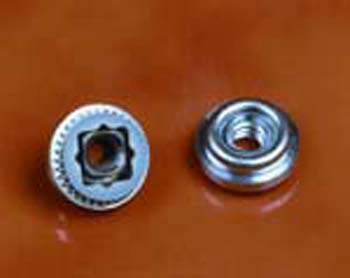Self-Clinching Floating Locking Nuts
Welcome to our comprehensive product description for Self-Clinching Floating Locking Nuts. In this guide, we will explore the world of these innovative and reliable fastening solutions that provide a secure and vibration-resistant method for attaching components in various applications. Self-clinching floating locking nuts are designed to be installed permanently by pressing them into pre-punched holes in metal sheets or panels. These nuts feature a unique floating thread design that allows for slight misalignment during assembly, making them ideal for applications where components may shift or experience vibrations during operation.
Key Features and Benefits
Self-clinching floating locking nuts offer a wide range of features and benefits that make them stand out in the fastening industry. Let's explore some of their key advantages:
- Floating Thread Design: The floating thread design allows the nut to self-align with mating screws, even when the components are misaligned, ensuring a secure connection.
- Reliable Locking: These nuts feature a locking element that prevents loosening caused by vibration, ensuring a stable and reliable connection over time.
- Simple Installation: The installation process involves pressing the nut into a pre-punched hole, eliminating the need for additional hardware or tools.
- Secure Attachment: Once installed, self-clinching floating locking nuts create a strong and permanent threaded post, ensuring a secure and robust fastening solution.
- High Strength: Despite their compact size, these nuts offer excellent load-bearing capacity, making them suitable for demanding applications.
- Vibration Resistance: The locking feature prevents self-clinching floating nuts from coming loose under vibration, ensuring long-term stability in the assembly.
- Materials and Finishes: Self-clinching floating locking nuts are available in various materials, including stainless steel, steel, and aluminum, with optional plating or coatings for enhanced performance in different environments.
- Versatile Applications: These nuts are used in industries such as electronics, automotive, aerospace, industrial machinery, and more.
- Cost-Effective: Self-clinching floating locking nuts streamline the assembly process, leading to increased efficiency and reduced labor costs.
Types of Self-Clinching Floating Locking Nuts
Self-clinching floating locking nuts come in different styles and sizes to accommodate various application requirements. Some common types include:
- Hexagonal Floating Locking Nuts: These nuts have a hexagonal shape, allowing for easy installation using standard tools like wrenches or sockets.
- Round Floating Locking Nuts: These nuts have a round shape and are commonly used in applications where a low-profile and flush appearance is desired.
- Blind Floating Locking Nuts: These nuts have a closed bottom end, making them ideal for applications where the bottom side of the panel is not accessible.
Applications
Self-clinching floating locking nuts find numerous applications in various industries due to their reliability and vibration resistance. Some common applications include:
- Electronics: Used in PCBs, electronic enclosures, and racks for secure fastening of components in high-vibration environments.
- Automotive: Found in automotive assemblies for attaching components and modules that experience constant vibration and dynamic loads.
- Aerospace and Aviation: Used in aircraft interiors, avionics, and cabin assemblies for critical and high-reliability applications.
- Industrial Machinery: Utilized in control panels, robotics, and automation systems for reliable fastening in high-vibration settings.
- Telecommunications: Found in networking equipment and data centers for secure and vibration-resistant attachment of electronic components.
- Medical Devices: Used in medical equipment and devices where stability and vibration resistance are critical.
- Consumer Electronics: Employed in smartphones, laptops, and other devices for secure and durable fastening.
Installation Process
The installation of self-clinching floating locking nuts is a simple process that involves the following steps:
- Preparation: Ensure that the panel has the correct hole size and design for the specific nut.
- Insertion: Insert the nut into the pre-punched hole.
- Application of Force: Using a press or installation tool, apply sufficient force to the nut to clinch it securely into the panel material.
- Verification: Confirm that the nut is correctly installed and providing a secure threaded post.
Quality Assurance
Our self-clinching floating locking nuts are manufactured to meet stringent quality standards and industry certifications. We are committed to providing products that consistently meet or exceed customer expectations. Our production facilities adhere to ISO 9001 and other relevant quality management systems, ensuring the highest level of quality and reliability in every nut we produce.
Conclusion
In conclusion, our Self-Clinching Floating Lock Nuts offer a secure and vibration-resistant solution for various applications. With their unique floating feature and self-clinching installation, these nuts ensure reliable and consistent grip on threaded studs or bolts. Experience the efficiency and reliability of our Self-Clinching Floating Lock Nuts today.










